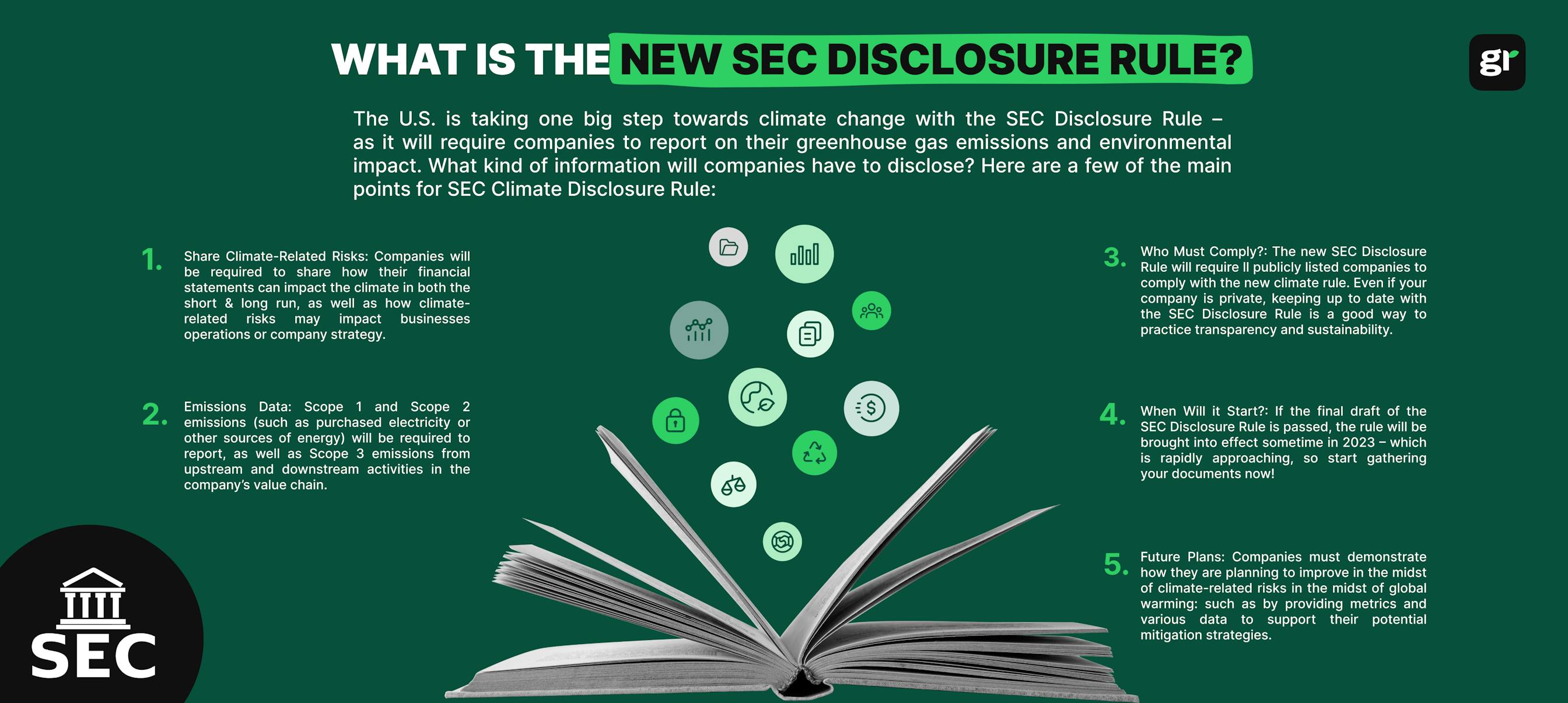
Sustainable Development Goals (SDGs): All You Need to Know
The United Nations has defined 17 goals, aimed at creating a better world. What are these so-called "Sustainable Development Goals" ? Explanations.
ESG / CSR
Industries



On March 6, 2024, the US SEC (United States Securities and Exchange Commission) finalized new rules that aim to both enhance and standardize climate-related disclosures. The move will provide clarity to companies and investors alike, however, the final draft represents a scaled-back version of the original proposal with Scope 3 emissions dropped from the text.
The new rules are also under threat after the Fifth US Circuit Court of Appeals granted an administrative stay, casting doubt over its future.
This article will cover everything you need to know about the new SEC climate-related disclosure rules, read on to find out more.
👉 What are the new climate-related disclosure rules? Who will they impact? And when will they come into effect?
On the 6th of March 2024, the SEC announced that it had formally adopted the highly-anticipated climate-related disclosure rules. Over 900 pages long and two years in the making, these rules aim to bring clarity and uniformity when it comes to climate-related disclosures by public companies and in public offerings.
The highly anticipated disclosure requirements come in response to increasing investor demand for more uniform and comparable information on the financial implications of climate-related risks. The rules will provide more transparency into how a company manages such risks, allowing investors to better assess investment opportunities.
The rules are also good news for companies, who finally have more clarity on what is expected of them in terms of disclosures. Companies will have to include the required information in their SEC filings (e.g in their annual reports and registration statements), effective from 2025.
The SEC has up until now steered clear of mandating the disclosure of climate-related risks, and has in the past only issued guidance (the last guidance related to climate disclosure was issued in 2010). The new rules, which were finalized on Wednesday 6th of March are the first time that the SEC has issued mandatory nationwide climate disclosure obligations.
The rules are the culmination of over two years of consideration and drafting and come in response to the increasing acknowledgment that climate change can, and does, impact a company’s financial performance.
💡 Up to USD 5 trillion annually is projected to be invested in sustainability by 2025, representing the largest capital reallocation in history. Consumers and investors alike are increasingly factoring in sustainability and climate risk when it comes to their investment decisions. This realignment of priorities will transform business in the US.
The new SEC rule has grown out of a wider global shift. Increasing numbers of countries and jurisdictions, such as the UK, Japan, and the EU, are implementing their own mandatory reporting of climate-related risks and opportunities. Additionally, a number of international institutions have published guidelines for voluntary disclosures - guidelines such as the Task Force of Climate-related Financial Disclosures (TCFD) which has been endorsed by over 2,600 companies.
Investors in the US were calling for a US rule to mandate similar reporting requirements, For investors, climate change has become a significant concern in recent years. Yet, in the US, without any obligated reporting, disclosures from companies were at times scant, and even when provided didn’t always facilitate easy comparison of data between companies.
This is why on March 21, 2022, the US SEC proposed a climate disclosure rule, requiring companies to provide information on their greenhouse gas emissions and environmental impact. The proposed rule was designed to provide clarity both about the company’s environmental impact and the impact of climate change on the organization's profitability and operations. Armed with this information investors would be able to make more informed decisions about the companies they choose to invest in.
SEC Commissioners voted with a 3 to 2 majority in favor of passing the new rules. However, the final draft is considerably less ambitious than the initial proposal. Still, the new obligation will likely impact thousands of companies across the US, requiring them to report their greenhouse gas emissions, material climate impacts, and any targets or transition plans.
The new SEC rules impact all domestic and foreign companies that file documents with the Securities and Exchange Commission. Otherwise referred to as registrants these companies are those conducting initial public offerings (IPO) and companies that file periodic reports.
There are a few exceptions to the above. Asset-backed issuers for example are exempt from the new rules, and SRCs (smaller reporting companies)), EGCs (emerging growth companies), and non-accelerated filers are exempt from GHG reporting but must provide all other disclosures.
💡 Around 5,300 corporations will fall under the scope of the new SEC rules. Including major organizations such as Chevron, Wells Fargo, and Amazon.
The new SEC climate disclosure rules include:



| Scope 1 and 2 GHG emissions | Material expenditures and impacts | Financial statement disclosures and all other disclosures | |
| SEC registrant type | |||
| Large accelerated filer | 2026 | 2026 | 2025 |
| Accelerated filer (excludes SRCs and EGCs) | 2028 | 2027 | 2026 |
| Non accelerated filer, SRCs, and EGCs | Not required | 2028 | 2027 |
*Disclosures to be included in annual reports or registration statements that include financial statements for the year ending December 31st.
Other important points to note regarding the implementation of the SEC climate disclosure rules include:
Many climate disclosure regulations have introduced the concept of double materiality, which means that a company must provide information covering both how the business is impacted by sustainability issues, and how their activities also impact the environment and society. Many hoped that the SEC climate-related disclosure rules would also implement this higher materiality standard, however, the SEC opted to adopt the concept of single materiality, which focuses on climate impacts on a company’s financial performance.
The SEC has clarified that with regard to the new climate disclosure rules, the term ‘materiality’ should align with the US Supreme Court's definition. According to this definition, “a matter is material if there is a substantial likelihood that a reasonable investor would consider it important when determining whether to buy or sell securities or how to vote, or such a reasonable investor would view the omission of the disclosure as having significantly altered the total mix of information made available.”

Not long after the SEC announced the approval of the finalised rule several US states announced a coalition intending to challenge the rule in the US Court of Appeals, stating that they believed the rule to be “illegal and unconstitutional”. They argue that the SEC has over-extended its power and that its new rule may also potentially violate First Amendment rights by requiring businesses to “disclose information that they might not otherwise want to”.
In a more recent update, on the 18th of March, 2024, a US appeals court placed a pause on the new rules in response to a lawsuit filed by oil-field-services firms Liberty Energy and Nomad Proppant Services. This may be the first of many attempts to prevent the rules from coming into effect. As the various lawsuits work their way through the US court system, it's possible that some companies may choose to delay their compliance.
Yet, the SEC is no stranger when it comes to pushback from Republican officials and businesses and has vowed to defend the climate-risk disclosure rules. However, the move to challenge the legality of the new rule may not just stem from Republican-led states, several environmental groups are also considering challenging the rules for an entirely different reason.
These groups criticize the watering down of the original proposal, calling it the “bare minimum”. The original proposed rule was greater in scope in that it not only covered Scope 1 and 2 emissions but also Scope 3 emissions. Given that for the average company over 70% of GHG emissions are related to Scope 3 it’s easy to understand why this omission from the final draft is seen as falling short.
Additionally, the Scope 1 and 2 disclosures have been narrowed down to include only those that are considered to be material for large-sized SEC-registered companies. Under the final rules, only 40% of US companies registered with the SEC will be large enough to meet the requirements for Scope 1 and 2 disclosures, if their emissions meet the materiality threshold.
SEC Commissioner, Caroline Crenshaw who voted in favour of the rule expressed her disappointment, stating “While these are important steps forward, they are a bare minimum”.
As companies gear up for the new climate disclosure rules set by the SEC, a well-structured approach is essential for seamless compliance. Here’s a strategic roadmap for companies to prepare effectively:
It's important to strengthen the company’s climate governance framework. This involves educating and aligning the board of directors, management, and employees with the details of the new SEC rule. Companies may need to either establish or refine their governance structures regarding climate issues, ensuring clear roles, responsibilities, and charters are in place for effective oversight.
Companies should conduct a thorough review of the climate-related information they currently collect and disclose. This step involves creating an inventory of existing data, alongside an assessment of the processes and controls that manage this information. Understanding the present state of climate disclosure provides a foundation for future improvements.
Another important aspect is identifying gaps in climate-related data, controls, and reporting practices. This includes examining disclosures both within and outside financial statements. Recognizing these gaps will guide companies in making necessary adjustments to their reporting processes.
Preparing for the new disclosure requirements might require additional resources. Companies should evaluate their current capabilities in terms of personnel, processes, and technology, and plan accordingly to meet reporting timelines efficiently.
Creating a detailed action plan for implementing the final rules is important. This plan should integrate with existing efforts related to other climate reporting requirements where applicable.
Finally, companies should start executing their action plan. As they progress, they may need to adapt to new developments and learnings in order to ensure continuous improvement and compliance.

At Greenly, we can help you to assess your company’s carbon footprint, and then give you the tools you need to cut down on emissions. Why not request a free demo with one of our experts - no obligation or commitment required.
If reading this article has inspired you to consider your company’s own carbon footprint, Greenly can help. Learn more about Greenly’s carbon management platform here.